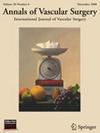Five Year Outcomes after Fenestrated Endovascular Aortic Repair in Octogenarians
IF 1.6
4区 医学
Q3 PERIPHERAL VASCULAR DISEASE
引用次数: 0
Abstract
Background
Elderly patients are prone to complications in aortic surgery. Fenestrated endovascular aortic repair (FEVAR) can be used to treat complex abdominal aortic aneurysms (AAAs). We describe 5-year results with FEVAR using the Zenith Fenestrated device (ZFEN) in an elderly population.
Methods
This is a retrospective review of all FEVARs between January 2012 and August 2019 at a tertiary academic medical center. The study compared 60-month outcomes for patients younger than 79.9 (Group 1) and greater than 80.0 years (Group 2). The primary outcome was mortality. Secondary outcomes included reintervention and complications.
Results
153 patients met inclusion criteria, 27 of whom were age ≥80.0 years and were included in Group 2. Group 1 had more active smokers at surgery (50.0% vs. 18.5%, P = 0.003) and higher body mass index (29.0 ± 6.1 vs. 25.4 ± 3.4, P = 0.004). The remaining baseline comorbid conditions and medications did not differ between groups. Length of stay (3.5 vs. 3.7 days, P = 0.88) and need for facility discharge did not differ (10.3% vs. 7.4%, P = 0.13). At 60 months, the estimated overall survival was not different between groups (66.7% Group 2 vs. 73.8% Group 1, P = 0.55). Estimated freedom from reintervention also did not differ at 60 months (81.5% Group 2 vs. 72.2% Group 1, P = 0.16).
Conclusion
FEVAR with ZFEN is safe and effective for the treatment of complex AAA in patients older than 80 years. Five-year outcomes, overall survival, and complications did not differ between groups, suggesting benefit of performing elective aneurysm repair in well selected elderly patients.
80多岁老人开窗主动脉腔内修复术后的5年预后。
目的:高龄患者在主动脉手术中易出现并发症。开窗血管内主动脉修复术(FEVAR)可用于治疗复杂腹主动脉瘤(AAA)。我们描述了在老年人群中使用Zenith开窗装置(ZFEN)平台进行FEVAR的5年结果。方法:回顾性分析某三级学术医疗中心2012年1月至2019年8月的所有FEVARs。该研究比较了年龄小于79.9岁(第一组)和大于80.0岁(第二组)患者的60个月预后。主要结局是死亡率。次要结局包括再干预和并发症。结果:153例患者符合纳入标准,其中27例年龄≥80.0岁,纳入第2组。1组手术时活跃吸烟者较多(50.0%比18.5%,p=0.003), BMI较高(29.0±6.1比25.4±3.4,p=0.004)。其余的基线合并症和用药情况在两组之间没有差异。住院时间(3.5天对3.7天,p=0.88)和出院需要没有差异(10.3%对7.4%,p=0.13)。60个月时,两组总生存率无差异(组2为66.7%,组1为73.8%,p=0.55)。在60个月时,估计的再干预自由度也没有差异(组2 81.5% vs组1 72.2%,p=0.16)。结论:FEVAR联合ZFEN平台治疗80岁以上复杂AAA患者安全有效。5年预后、总生存率和并发症在两组之间没有差异,这表明在精心挑选的老年患者中进行择期动脉瘤修复是有益的。
本文章由计算机程序翻译,如有差异,请以英文原文为准。
求助全文
约1分钟内获得全文
求助全文
来源期刊
CiteScore
3.00
自引率
13.30%
发文量
603
审稿时长
50 days
期刊介绍:
Annals of Vascular Surgery, published eight times a year, invites original manuscripts reporting clinical and experimental work in vascular surgery for peer review. Articles may be submitted for the following sections of the journal:
Clinical Research (reports of clinical series, new drug or medical device trials)
Basic Science Research (new investigations, experimental work)
Case Reports (reports on a limited series of patients)
General Reviews (scholarly review of the existing literature on a relevant topic)
Developments in Endovascular and Endoscopic Surgery
Selected Techniques (technical maneuvers)
Historical Notes (interesting vignettes from the early days of vascular surgery)
Editorials/Correspondence

 求助内容:
求助内容: 应助结果提醒方式:
应助结果提醒方式:


